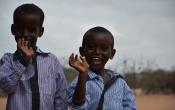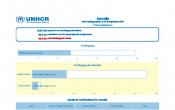Somalia
Operation: Somalia
Location
{"longitude":45,"latitude":6,"zoom_level":0}
Latest update of camps and office locations 21 Nov 2016. By clicking on the icons on the map, additional information is displayed.
Key Figures
| 2016 end-year results | |
| 71,400 | internally displaced people (9,400 households) affected by flooding and conflict received non-food item kits, 1,500 IDP households received plastic sheets and a further 1,000 IDP household received solar lanterns |
| 33,800 | returnees (6,700 households) were provided with reintegration assistance |
| 7,400 | school-age refugee children had access to primary education and related assistance |
| 7,400 | people of concern were assisted with basic primary healthcare services |
| 5,500 | returnee students had access to primary and secondary education and provided with scholastic materials |
| 1,500 | IDP were integrated through provision of permanent shelter, latrines and community centres |
| 500 | water trucks (equal to 3.5 million litres of water) were provided to drought-affected people in Bari, Nugaal, Sool, and Sanag regions |
| 2017 planning figures | |
| 80% | of primary school-aged refugee and asylum-seeking children will be enrolled in primary education |
| 40% | of Somali returnee households will be living in adequate dwellings |
| 35% | of refugee and asylum-seeking people of concern (18-19) targeted with own business/self-employed |
| 32% | of returning people of concern (18-19) targeted with own business/self-employed |
Latest Updates and Related Links
People of Concern
37%
Increase in
2016
2016
| 2016 | 1,623,185 |
| 2015 | 1,188,631 |
| 2014 | 1,160,286 |

[["Refugees",11574],["Asylum-seekers",12794],["IDPs",1562554],["Returned refugees",36133],["Others of concern",130]]
Loading ...
Somalia
< Back
2016
{"categories":[2012,2013,2014,2015,2016,2017],"budget":[48.71903122,55.30925953,69.833919642,99.153880316,165.91668118,116.59981857],"expenditure":[24.72943047,23.14684963,26.5332932,36.1882683,50.90649389,null]}
{"categories":[2012,2013,2014,2015,2016,2017],"p1":[9.59466285,9.03116226,24.124382822,44.514196076,93.4138341,53.54516246],"p2":[null,null,null,null,null,null],"p3":[null,null,11.40125058,13.09633044,34.86243341,23.49323017],"p4":[39.12436837,46.27809727,34.30828624,41.5433538,37.64041367,39.56142594]}
{"categories":[2012,2013,2014,2015,2016,2017],"p1":[4.63287788,5.57949325,7.83034228,19.02820407,29.51135868,null],"p2":[null,null,null,null,null,null],"p3":[null,null,3.1304473,6.92298829,8.31500207,null],"p4":[20.09655259,17.56735638,15.57250362,10.23707594,13.08013314,null]}
Loading ...
CHOOSE A YEAR
- 2014
- 2015
- 2016
- 2017
Working environment
In 2016, Somalia continued to face instability, extreme poverty, food insecurity and a complex political environment where decades of acute humanitarian needs persist. Low economic performance, limited livelihood opportunities and environmental degradation, have drastically affected the wellbeing of refugees and asylum seekers and Somali refugee returnees and internally displaced people (IDPs) in particular.The security situation further deteriorated in 2016 with Al-Shabaab controlling large parts of southern and central Somalia and carrying out terrorist attacks, thereby restricting the peace process and humanitarian access.
For the third time in 2016, the Somalia Government delayed presidential elections.
Despite the challenging operational environment given the persisting political and security volatility, Somalia continues to be on a positive political trajectory.
Population trends
- In 2016, some 24,500 refugees and asylum-seekers were registered in Somalia. Since the beginning of the voluntary repatriation in 2014 to December 2016, close to 40,000 Somali nationals were repatriated in Somalia, as per UNHCR Somalia data management record (in 2016 alone 33,792 persons were repatriated). Since the beginning of the Yemen response from 2015 to 2016, close to 29,500 Somali nationals returned to Somalia from Yemen (in 2016, a total of 2,963 people were received).
- There were over 1.4 million internally displaced people within Somalia, out of which, 890,000 in South and Central Somalia with the majority (400,000) located in and around Mogadishu.
Achievements and impact
- UNHCR continued to support some 24,400 refugees and asylum seekers, over 180,000 IDPs and vulnerable host community households with improved access to education, health, self-reliance, livelihood initiatives and community-based projects in 2016.
- Close to 33,800 Somalis voluntarily returned from Kenya and were assisted with enhanced reintegration assistance. The return package was enhanced in July 2016 to anchor return and avoid further displacement. Community-based initiatives aiming at promoting co-existence with local communities were implemented in the second half of the year.
- The Governments of Puntland, Somaliland and the Federal Government of Somalia have agreed to recognize all Yemeni nationals seeking asylum in Somalia as prima facie refugees upon arrival.
- The reception centres in the port cities of Berbera and Bossaso have been set up in coordination with regional Somali Governments of Somaliland and Puntland respectively to register Yemenis and other refugees including Somalis returning from Yemen. They are equipped with basic accommodation, health and WASH facilities including registration desk along with onward transportation for those opting to travel further.
- The IDP policy in Hargeisa was endorsed by the Cabinet in January 2016. The Protection Cluster in Somaliland transitioned to an IDP Solution Task-Force led by the MRRR with a focus on durable solutions for protracted IDP population.
- UNHCR enhanced its leadership in the Protection and Shelter/NFI Clusters through dedicated national cluster coordinators, increasing efficiency of coordination and strengthened prevention and response capacity.
- Emergency response was set up by the Government and coordinated by OCHA in response to drought in Somaliland.
Unmet needs
- Volatile security environment hampered UNHCR project implementation.
- There is a lack of infrastructure and basic services in IDP settlements and urban areas are being overwhelmed with the influx of new arrivals.
- Provision of sustainable livelihoods, including a continuous support for enhanced self-reliance and access to basic needs, such as health and education, remains unmet.
- Coordination requires substantial human resources. However, Protection and Shelter clusters have only limited dedicated staff covering the entire country.
Providing protection and durable solutions to people of concern will continue to be UNHCR’s overarching goal in Somalia in 2016. Given the unstable and unpredictable environment that is likely to persist in the country, the approach towards solutions will remain tailored, phased and customized.
Special efforts will be made to support relevant Government ministries and departments with expertise, technical advice and capacity building, both at federal and regional levels in south-central Somalia, Puntland, and Somaliland, in order to help develop a national internally displaced person (IDP) and refugee policy framework.
On the basis of the comprehensive solutions strategy for people of concern developed in 2015 with the Somali authorities and other international partners, UNHCR will continue to implement a series of pilot projects at different locations, to support local integration (in case of protracted IDPs), the voluntary return of refugees and IDPs, and reintegration in areas of return (enhancing self-reliance and access to basic services). This will be based on the lessons learned from: the voluntary return pilot project initiated in December 2014; the IDP returns supported by the UNHCR-led “Return Consortium”; and the IDP local integration/self-reliance pilots in Galkayo and Hargeisa. Resettlement will be used as a protection tool for refugees with specific needs and without any other prospects of a durable solution.
In south-central Somalia, while protracted IDP situations will begin to resolve as durable solutions are achieved, it is expected that returning Somali refugees will be the focus in 2016. Return and initial reintegration packages will be provided to reduce the risk of further displacement. Reintegration activities (e.g. livelihoods, rehabilitation of basic infrastructure) will follow a community-based approach to ensure that assistance benefit IDPs, refugee returnees as well as host populations, and that conflict over resources can be avoided. This will be done in close coordination with development actors, and UNHCR will advocate for the engagement of UN agencies, NGOs, financial institutions and others in meeting the reintegration and development needs of people of concern.
In Puntland and Somaliland, where the majority of refugees and asylum-seekers are located, UNHCR will continue to implement its policy on refugee protection and durable solutions in urban areas while durable solutions are being identified. Emphasis will be on registration and documentation, community outreach, sexual gender-based violence prevention and access to basic services through inclusion in national systems (e.g. health, education). Partnership with local authorities will be strengthened to promote the sustainability of all interventions.
Through its leadership and coordination roles for two clusters (protection and shelter/non-food items), UNHCR will maintain its capacity to respond to urgent needs and provide assistance to the most vulnerable IDPs in emergency situations.
As in previous years, UNHCR will maintain its capacity to track displacements and monitor returns, as well as to assess the overall protection situation in the country, through the Protection and Return Monitoring Network (PRMN). Analysis of the data will form the basis for detailed planning of UNHCR interventions.
Should there be a shortfall in funding, more than 80 per cent of refugee and IDP returnees would not receive a return assistance package, thus compromising the sustainability of returns. There would be a reduction in self-reliance activities for returning refugees; this would also affect the sustainability of returns and potentially trigger secondary displacement, both internally and externally. The lack of core relief items available would reduce the Office’s ability to respond to emergencies, and the PRMN would have to be redirected to cover only south-central Somalia, resulting in the risk of gaps in information about population movements and protection needs in the less accessible areas of Puntland and Somaliland.




